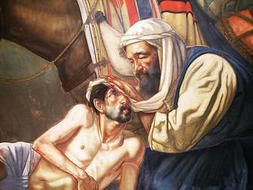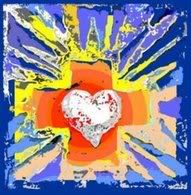The following are some of the most-asked Triduum questions answered by the United States Conference of Catholic Bishops' Committee on the Liturgy.1. When does the Triduum begin and end?The Easter Triduum begins with the evening Mass of the Lord’s Supper, reaches its high point in the Easter Vigil, and closes with evening prayer on Easter Sunday.
2. May another Mass besides the Mass of the Lord’s Supper be celebrated on Holy Thursday?Ordinarily, no other Mass may be celebrated on Holy Thursday. However, by way of exception, the local Ordinary may permit another Mass in churches and oratories to be celebrated in the evening, and, in the case of genuine necessity, even in the morning. Such Masses are provided for those who in no way are able to participate in the evening Mass.
3. How are the Holy Oils, consecrated and blessed on Holy Thursday, to be received in the parish?A reception of the oils may take place at the Mass of the Lord’s Supper. The oils, in suitable vessels are carried in the procession of the gifts, before the bread and wine by members of the assembly. A text for this can be found in the
Sacramentary Supplement 2004 recently published by
Catholic Book Publishing Company.
[Editor's note: Click here to find out how to dispose of old Holy Oils.]4. When should the celebration of the Lord’s Passion take place?Normally it should take place in the afternoon, at about three o'clock to enable people to assemble more easily. However, pastoral discretion may indicate a time shortly after midday, or in the late evening, though never later than nine o'clock. Depending on the size or nature of a parish or other community, the local ordinary may permit the service to be repeated.
5. Does the Church encourage any other liturgical celebrations on Good Friday?On this day the Office of Readings and Morning Prayer could appropriately be celebrated with the participation of the people in the churches.
6. Do devotions have a particular importance on Good Friday?The
Directory on Popular Piety and the Liturgy (2002) provides the proper perspective in paragraphs 142 – 145. Clearly the central celebration of this day is the Good Friday Liturgy of the Lord’s Passion. In no way should manifestations of popular piety, either by the time or manner in which they are convoked substitute for this solemn liturgical action. Nor should aspects of the various acts of piety be mixed with the Good Friday celebration, creating a hybrid. In recent times, Passion Processions and celebration of the Stations of the Cross, and Passion Plays have become more common. In such representations, actors and spectators can be involved in a moment of faith and genuine piety. Care should be taken, however, to point out to the faithful that Passion Plays are a representation which is commemorative and they are very different from “liturgical actions” which are anamnesis, or the mysterious presence of the redemptive event of the Passion.
7. How does the Veneration of the Cross on Good Friday begin?The Veneration of the Cross begins with one of two forms of Showing of the Cross:
- The first form begins as the deacon or another suitable minister goes to the sacristy and obtains the veiled cross. Accompanied by two ministers with lighted candles, the veiled cross is brought to the center of the sanctuary in procession. The priest accepts the cross and then standing in front of the altar and facing the people, uncovers the upper part of the cross, the right arm and then the entire cross. Each time he unveils a part of the cross, he sings "This is the wood of the cross."
- In the second form of the veneration of the cross, the priest or deacon goes to the church door, where he takes up the uncovered cross. Accompanied by two ministers with lighted candles, he processes to the sanctuary, stopping at the door of the church, in the middle of the church and before entering the sanctuary to sing the acclamation, "This is the wood of the cross."
8. How is the cross venerated by members of the Congregation on Good Friday?After the showing of the cross, the priest or deacon may carry the cross to the entrance of the sanctuary or another suitable place. The first person to adore the Cross is the priest celebrant. If circumstances suggest, he takes off his chasuble and his shoes. The clergy, lay ministers and the faithful then approach the cross. The personal adoration of the cross is an important feature in this celebration and every effort should be made to achieve it. The rubrics remind us that “only one cross” should be used for adoration. If the numbers are so great that all can not come forward, the priest, after some of the clergy and faithful have adored the cross, can take the cross and stand in the center before the altar. In a few words he invites the people to adore the Cross. He then elevates the cross higher for a brief period of time while the faithful adore it in silence. It should also be kept in mind that when a sufficiently large cross is used even a large community can reverence it in due time. The foot of the cross as well as the right and left arm can be approached and venerated. Coordination with ushers and planning the flow of people beforehand can allow for this part of the liturgy to be celebrated with decorum and devotion.
9. When should the Easter Vigil take place?The Vigil, by its very nature, ought to take place at night. It is not begun before nightfall and should end before daybreak on Easter Sunday. The celebration of the Easter Vigil takes the place of the Office of Readings. The Easter Vigil begins and ends in darkness. It is a nocturnal vigil, retaining its ancient character of vigilance, and expectation, as the Christian people await the resurrection of the Lord during the night. Fire is blessed and the paschal candle is lighted to illumine the night so that all may hear the Easter proclamation and listen to the word of God proclaimed in the Scriptures. For this reason the Service of Light takes place before the Service of the Word. Since sunset varies at different locations throughout the country, local weather stations can be consulted as to the time of sunset in the area.
[Editor's note: Sunset begins on this day in 2009 in San Jose at 7:39 p.m. and civil twilight ends at 8:06 p.m. Thus Easter Vigil for 2009 may not begin before 8:00 p.m.]10. What considerations should be given for the Paschal Candle used at the Easter Vigil?This candle should be made of wax, never be artificial, be replaced each year, be only one in number, and be of sufficiently large size that it may convey the truth that Christ is the light of the world. The Paschal Candle is the symbol of the
light of Christ, rising in glory, scattering the darkness of our hearts and minds. Above all, the Paschal Candle should be a genuine candle, the pre-eminent symbol of the light of Christ. Choice of size, design, and color should be made in relationship to the sanctuary in which it will be placed.
[Editor's note: Click here to find out how to appropriately dispose of last year's Paschal Candle.]11. How many readings should be proclaimed at the Easter Vigil?One of the unique aspects of the Easter Vigil is the recounting of the outstanding deeds of the history of salvation. These deeds are related in seven readings from the Old Testament chosen from the law and the prophets and two readings from the New Testament, namely from the apostles and from the gospel. Thus, the Lord “beginning with Moses and all the prophets” (Lk 24.27, 44-45) meets us once again on our journey and, opening up our minds and hearts, prepares us to share in the breaking of the bread and the drinking of the cup. The faithful are encouraged to meditate on these readings by the singing of a responsorial psalm, followed by a silent pause, and then by the celebrant’s prayer. Meditation on these readings is so significant for this night that we are strongly urged to use all the readings whenever it can be done. Only in the case of grave pastoral circumstances can the number of readings be reduced. In such cases, at least three readings from the Old Testament should be read always including Exodus 14.
12. How is the First Communion of the neophytes to be emphasized during the Easter Vigil?The celebrant, before he says,
This is the Lamb of God, may make a brief remark to the neophytes about their first Communion and about the importance of so great a mystery, which is the climax of initiation and the center of the Christian life. This is a night when all should be able to receive Holy Communion under both forms.
13. What directions are given for the celebration of Masses on Easter Sunday?Mass is to be celebrated on Easter Day with great solemnity. A full complement of ministers and the use of liturgical music should be evident in all celebrations. It is appropriate that the penitential rite on this day take the form of a sprinkling with water blessed at the Vigil, during which the antiphon
Vidi aquam, or some other song of baptismal character should be sung. The holy water fonts at the entrance to the church should also be filled with the same water. On Easter Sunday the rite of renewal of baptismal promises is repeated after the homily.
[Editor's note: Click here to find out which prayer to use over water that has already been blessed.]14. Where is the Paschal Candle placed during the Easter Season?The paschal candle has its proper place either by the ambo or by the altar and should be lit at least in all the more solemn liturgical celebrations of the season until Pentecost Sunday, whether at Mass, or at Morning and Evening Prayer. After the Easter season the candle should be kept with honor in the baptistry, so that in the celebration of Baptism the candles of the baptized may be lit from it. In the celebration of funerals the paschal candle should be placed near the coffin to indicate that the death of a Christian is his own Passover. The paschal candle should not otherwise be lit nor placed in the sanctuary outside the Easter season.
Copyright © 2004, Bishops Committee on the Liturgy. Reprinted with permission.
 There is a bill going through Congress right now that would make being an undocumented immigrant a felony, requiring jail time and barring the person from any future legal status or re-entry into the US. It would also make it a felony, requiring five years jail time, for anyone or any organization to assist, transport, or harbor an undocumented person in such a way that it aids or furthers the person's presence in the US.
There is a bill going through Congress right now that would make being an undocumented immigrant a felony, requiring jail time and barring the person from any future legal status or re-entry into the US. It would also make it a felony, requiring five years jail time, for anyone or any organization to assist, transport, or harbor an undocumented person in such a way that it aids or furthers the person's presence in the US.
 The Chrism Mass needs music ministers of all ages and abilities. If you would like to sing or play an instrument for this year's Chrism Mass, please see the information below on rehearsals.
The Chrism Mass needs music ministers of all ages and abilities. If you would like to sing or play an instrument for this year's Chrism Mass, please see the information below on rehearsals.

 If your parish submitted names of candidates for the
If your parish submitted names of candidates for the  Lenten liturgies have a quality of sobriety and simplicity. But remember that "sober" and "simple" do not mean "boring" or necessarily "straight out of the book." Simple, sober liturgy is elegant liturgy that pays attention first to the primary symbols and keeps in mind the small details. Lent is the perfect time to do the basic things very well. (The following article by Diana Macalintal originally appeared in
Lenten liturgies have a quality of sobriety and simplicity. But remember that "sober" and "simple" do not mean "boring" or necessarily "straight out of the book." Simple, sober liturgy is elegant liturgy that pays attention first to the primary symbols and keeps in mind the small details. Lent is the perfect time to do the basic things very well. (The following article by Diana Macalintal originally appeared in  In addition to the 8 sets of invocations for Form C of the Penitential Rite, the rubrics allow for other invocations to be used. One reason to write original invocations is to relate them more closely to the readings of the day. When crafting original invocations, use the current 8 options as models and keep the following in mind:
In addition to the 8 sets of invocations for Form C of the Penitential Rite, the rubrics allow for other invocations to be used. One reason to write original invocations is to relate them more closely to the readings of the day. When crafting original invocations, use the current 8 options as models and keep the following in mind:





